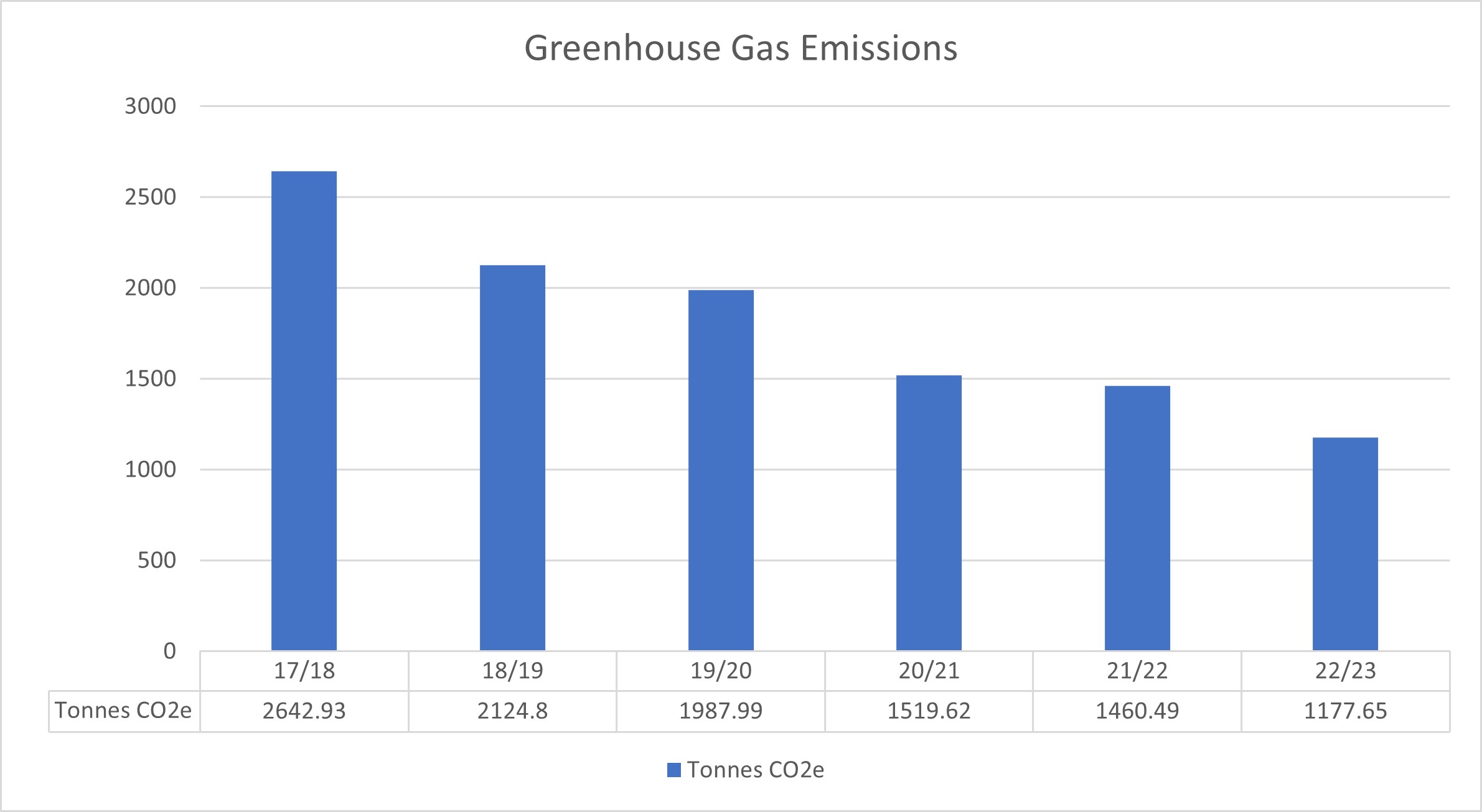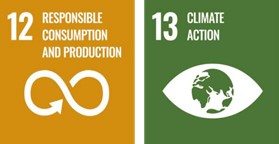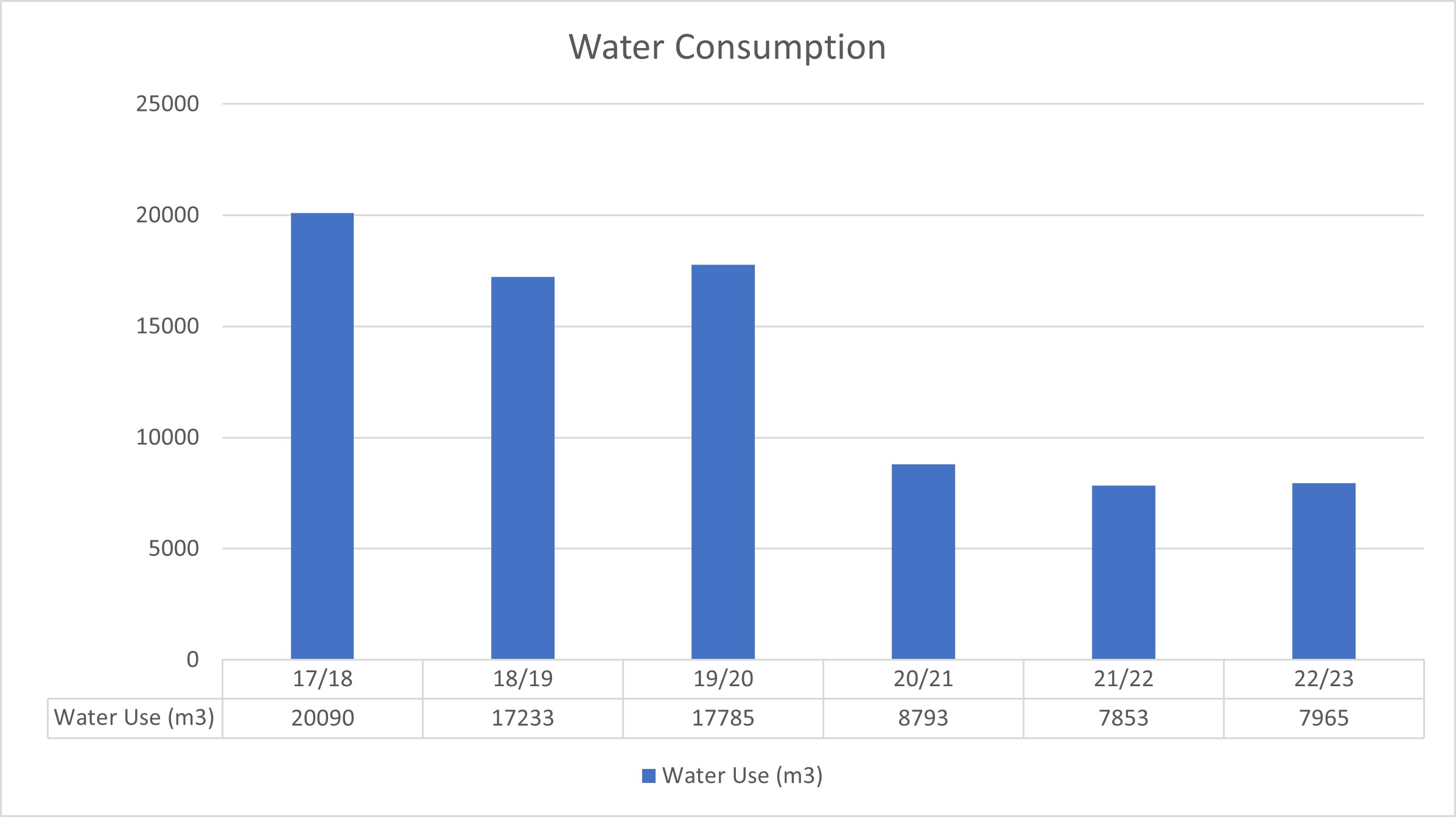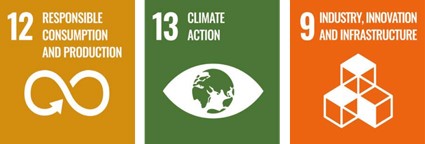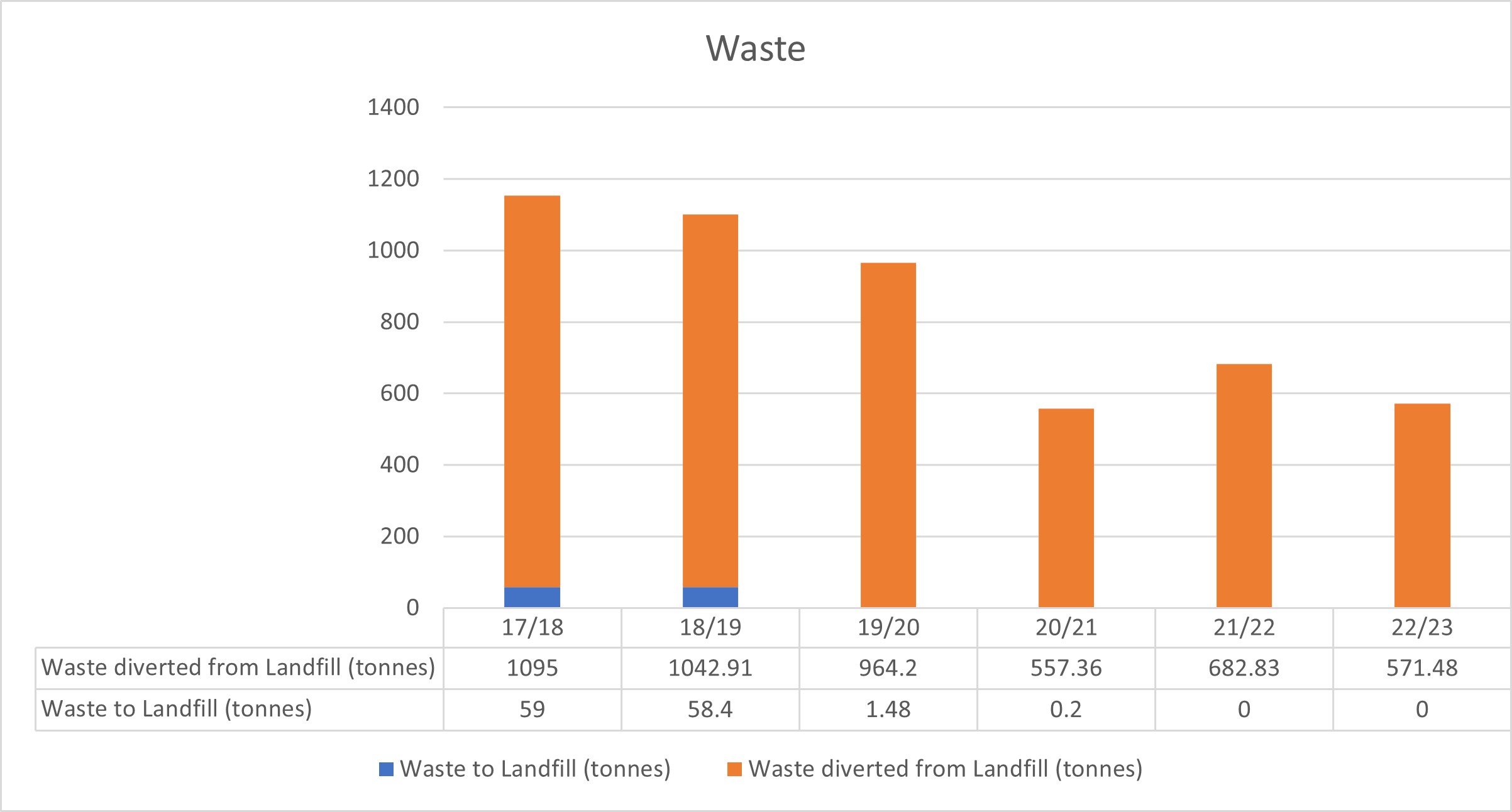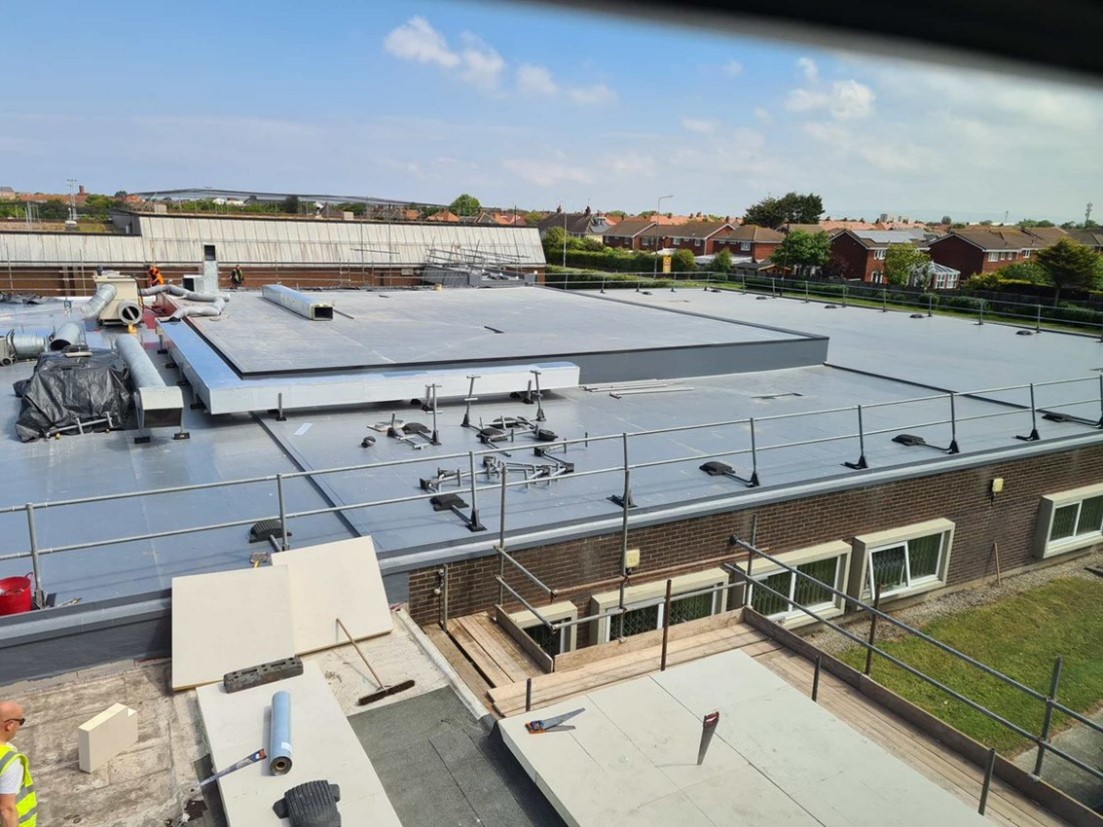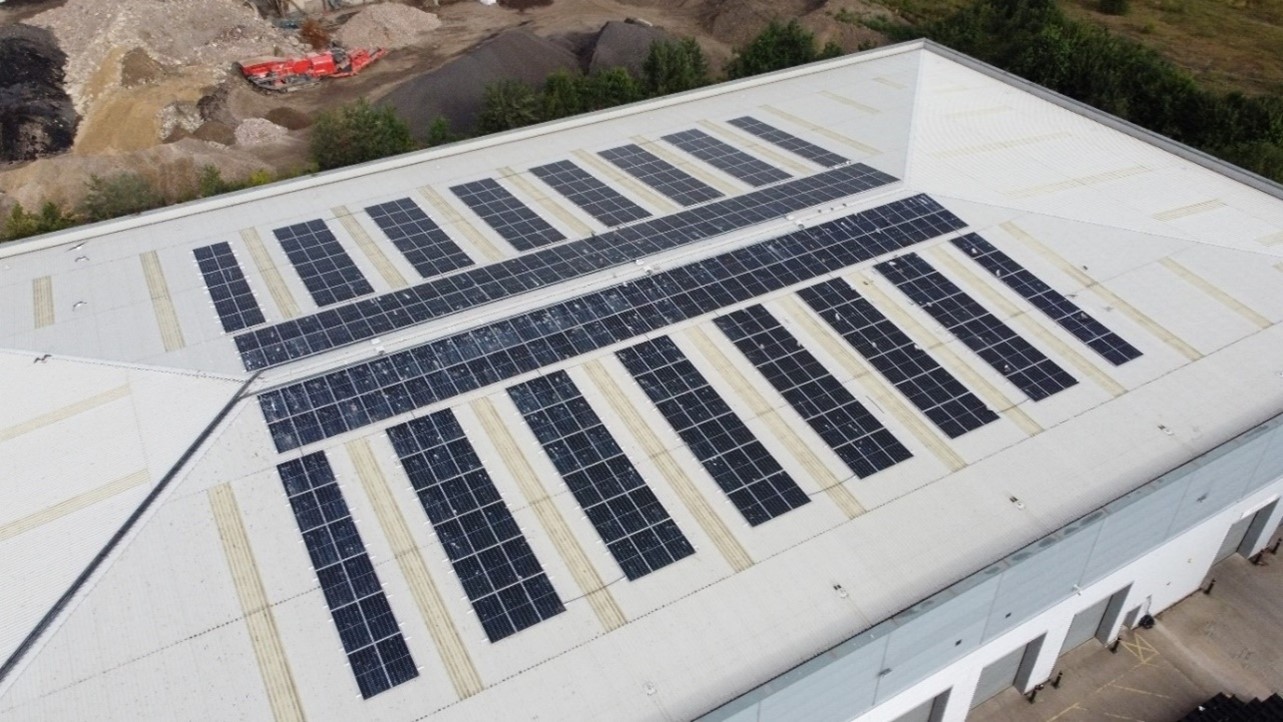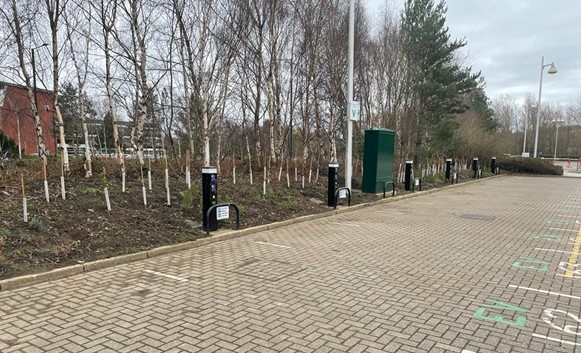Overview
Environment and resource efficiency performance review 2022/23
Throughout our performance review we have evaluated where our work supports the UN Sustainable Development Goals (SDG) and have indicated which goal using the relevant SDG tile.
Table 1 summarises our internal targets and performance up to the end of 2022/23. It should be noted that in many cases our internally set targets, aligned to our business strategy, stretch us much further than the mandated Greening Government Commitments (GGC) targets.
The GGC scheme for 2021-25 aligns to cross-government policy and existing commitments and expands the number of headline commitments we need to report on centrally and sets a range of sub-commitments supporting key sections of GGCs.
GGC 2021-25 introduced ambitious targets for core areas of greenhouse gas emissions, water, waste and paper and also introduced measures for ICT & digital services, climate change risk and adaptation, biodiversity and food waste. The SHE Team continue to work with stakeholders across the organisation to implement the GGCs.
|
2022/23 Targets |
2022/23 performance |
|---|---|
|
35% reduction in greenhouse gas emissions (Greening Government target: 44% by 2025) |
59% |
|
40% reduction in water consumption (Greening Government target: Reduce water consumption by 8% by 2025) |
60% |
|
30% reduction in waste generated (Greening Government target: Reduce overall amount of waste generated by 15% by 2025) |
51% |
|
Less than 5% of waste to landfill (Greening Government target: Less than 5% of waste to landfill) |
0% |
|
Increase the proportion of waste recycled to at least 80% of overall waste (Greening Government target: Increase the proportion of waste recycled to at least 70% of overall waste by 2025) |
90% |
|
45% reduction in office paper use (Greening Government target: 50% reduction in office paper use by 2025) |
36% |
Note that targets relate to the end of 2022/23, based on a revised 2017/18 baseline. All waste data relates to operational waste and excludes construction waste.
A detailed summary of our environmental and related financial data is given in the appendix, along with performance commentary. The following figures give a high-level summary of our performance against our baseline year of 2017/18.
Greenhouse gas emissions
Graphic showing approximate volume of CO2 emissions in tonnes by year:
Gas consumption has substantially decreased across the estate during 2022/23. During 2021/22 our response to COVID-19 changed how we operated our air conditioning systems, this circulated fresh air, increasing our heating demand and gas consumption throughout the winter months. As this ventilation policy is no longer in operation, building heating demand has reduced along with our gas consumption. This change combined with the consolidation of the NHSBSA estate has reduced demand for gas.
During 2022/23 fleet travel has decreased by almost 50% (approximately 49,800 miles) compared to 2021/22. Staff are well established in their working-from-home set up, therefore reducing the use of fleet vehicles to distribute homeworking equipment. The consolidation of the NHSBSA estate has also contributed to the reduction in fleet travel as fewer miles were travelled between sites.
We have continuously reduced our electricity consumption across our estate over the last few years. This is due to low occupancy levels across all sites and the consolidation of the estate. Likewise, we have reduced our business travel significantly due to the pandemic - replacing face-to-face meetings with online meetings. The business continues to learn from such positive changes, for example ensuring that unnecessary travel is not undertaken.
Overall, we have continued to see a downward trend in our greenhouse gas emissions.
Water consumption
Graphic showing NHSBSA water use in cubic metres by year
Water use across the NHSBSA estate has remained consistent with 2021/22’s usage. Although an increased number of staff have begun returning to offices, the consolidation of the estate has offset any increase as a result. The volume of water consumed remains significantly less when compared to pre-pandemic usage. Our Estates team continues to monitor water usage site-by-site and look at operational improvements where appropriate.
Waste reduction and diversion from landfill
Data showing NHSBSA waste diverted from landfill and sent to landfill, by year:
| Year | Waste diverted from landfill (tonnes) | Waste to landfill (tonnes) |
|---|---|---|
| 2017/18 | 1095.00 | 59.00 |
| 2018/19 | 1042.91 | 58.40 |
| 2019/20 | 964.20 | 1.48 |
| 2020/21 | 557.36 | 0.20 |
| 2021/22 | 682.83 | 0.00 |
| 2022/23 | 571.48 | 0.00 |
We have continued to make improvements to many of our services which has reduced our reliance on paper processes. We have continued to promote use of the Electronic Prescription Service (EPS) with over 90% of prescriptions being processed electronically, which has significantly reduced our paper waste. Furthermore, the 'Manage Your Service' to prevent the introduction of paper forms has continued to be expanded. Due to reduced building occupancy, we have seen a reduction in general office-based waste across all of our sites.
Construction waste has been excluded from all NHSBSA waste KPIs to allow for better monitoring of operational waste and shall be incorporated into this Annual Report year-end data tables for transparency.
We have continued to meet the Greening Government Commitments target of sending less than 10% of our waste to landfill through our waste management practices and contractual arrangements. We continue to monitor the growth of our business and on-boarding of new services, and the impact this will have on our waste figures.
Paper usage
Graphic showing NHSBSA paper usage in reams of A4-equivalent paper, by year:
Previously we have reduced our paper consumption through the delivery of our service improvement programmes by providing the option of digital solutions. This includes facilitating 2.23 million NHS employees receiving electronic payslips through Electronic Staff records (ESR).
In Q3 2021/22 our Exemption Checking Services resumed which increased the number of letters being issued, this service continues to operate during 2022/23 with an additional enquiry letter required to be sent to service users. The addition of this third letter and the hold being removed from the service has caused paper usage to increase during 2022/23.
Our service providers and digital teams continue to innovate and develop our move to digital service platforms.
Key areas of activity during 2022/23
Environment Strategy 2022-25
The Environment Strategy 2022-25 was launched this year and has been written to reflect the ambition and priority of environmental improvement at the NHSBSA. The strategy has been informed by industry best practice, requirements of mandatory Government policy and in consultation with key internal and external stakeholders. This Strategy is supported by an annual Environmental Action Plan which details actions we will take against each of our environmental priorities.
Climate emergency
On 23 September 2020 the NHSBSA declared a climate emergency to recognise the risk posed by global warming and climate change. Our activity has continued to be overseen by the Environment Committee which has met on a quarterly basis and is chaired by our Chief Executive and attended by senior management. Environmental Sustainability has continued to be one of the NHSBSA’s corporate goals, which will be delivered through the implementation of the Environment Strategy 2022-25. We have also continued to engage and support our colleagues and leaders on climate action through our Climate Action Toolkit and bespoke environmental awareness sessions.
Net Zero target by 2030
During 2022/23, we delivered a range of Estates related environmental improvement schemes. To improve the energy efficiency of our estate the air conditioning has been upgraded in our comms rooms, as well as a roof insulation scheme to reduce heat loss at Hesketh House. At Greenfinch Way an LED lighting scheme has resulted in an 18% reduction in lighting load and a 5% overall reduction in energy use. We have also installed an array of solar photovoltaics (PV) at Greenfinch Way which has provided over £29,000 in annual energy saving. At Stella House we have installed 32 electric charging posts for colleagues to utilise to support the uptake of electric vehicles. Moving forward we will continue to monitor the changing estate and strategically review where future schemes should be prioritised.
ISO 14001:2015
Environment Committee
Our Environment Committee, chaired by our Chief Executive and attended by senior management representatives across all areas of our business, has continued to operate throughout 2022/23. The committee oversees and makes decisions relating to our environmental sustainability agenda.
Environment Network
Throughout 2022/23 the Environment Network has continued to engage with colleagues across the business through developing and running awareness campaigns on different environmental topics. We have continued to engage largely online to improve accessibility; ensuring colleagues are connected nationally and can also advocate at a local level. The lifting of COVID-19 restrictions allowed in person activities to begin again. This has enabled activities such as environmental volunteering to commence. During 2022/23 we completed National Nature Cleans, which resulted in NHSBSA colleagues cleaning over 80 miles of beaches.
Biodiversity
Throughout 2022/23 we have been developing a Biodiversity Plan which sets a clear direction for how we will conserve and enhance biodiversity across our estate. At Stella House, we have replaced the invasive cotoneaster shrub with 1,380 low-level native flora plants of at least 20 species which will provide year round food and shelter to pollinators and other local wildlife such as small mammals and bird populations.
Communications and engagement
Throughout the year we have continued to engage the business on our environmental commitments and compliance obligations. We continue to utilise communications platforms such as the Intranet and an Environment Network community on our internal social media to engage and interact with our colleagues. Many of the channels we use to engage colleagues now allow for two-way communication, where colleagues can respond, share best practice and ask questions. A highlight of 2022/23 was providing Energy Cafes to provide information to colleagues about energy efficiency and support schemes to help with energy costs to support the Cost of Living and energy crisis which had over 200 colleagues in attendance.
Digitisation of our services
As part of our core business strategy, we are continuing to modernise and improve how we deliver our services. We are engaging with our customers and clients to improve the delivery of many of our services including those currently delivered using paper-based forms and admin-heavy processes. We have continued to develop and transform our services and continue to drive uptake of our digital services to remove waste and paper consumption at source.
For example, we continued to engage with NHS organisations to encourage the uptake of electronic payslips and throughout 2022/23 we reached 2.23 million NHS employees receiving electronic payslip through ESR, reducing the number of paper payslips we use. 2022/23 also saw the development of the new Prescription Prepayment Certificate to reduce the cost of hormone replacement therapy (HRT). This system was built with full digital journey in mind, resulting in 97% of applications being digital, drastically reducing the amount of paper used and waste produced. Finally, during 2022/23 the Low Income Scheme digital applications made up 64% of overall applications, a 28% increase from 2021/22. The digitisation of this service has removed the need for 259,000 16-page coloured booklets from being printed.
Sustainable procurement
The SHE/Commercial team continue to develop our Sustainable Procurement Plan which brings together and implements the requirements of the Social Value and Carbon Reduction PPNs, the procurement aspects of the new GGC scheme and industry best practice. During 2022/23 the Social Value model has been embedded thoroughly in our assessment of procurements which introduces requirements and targets for suppliers to improve their environmental performance in accordance with the Model.
Government policy continues to focus on the importance of sustainable procurement and the added value that can be achieved through encouraging and mandating suppliers to improve their environmental performance. We have been working collaboratively with wider health and social care organisations to ensure best practice. To further our understanding we have engaged with Sustainable Procurement colleagues at NHSE to use their expertise, setting up awareness sessions with our Commercial Services team.



